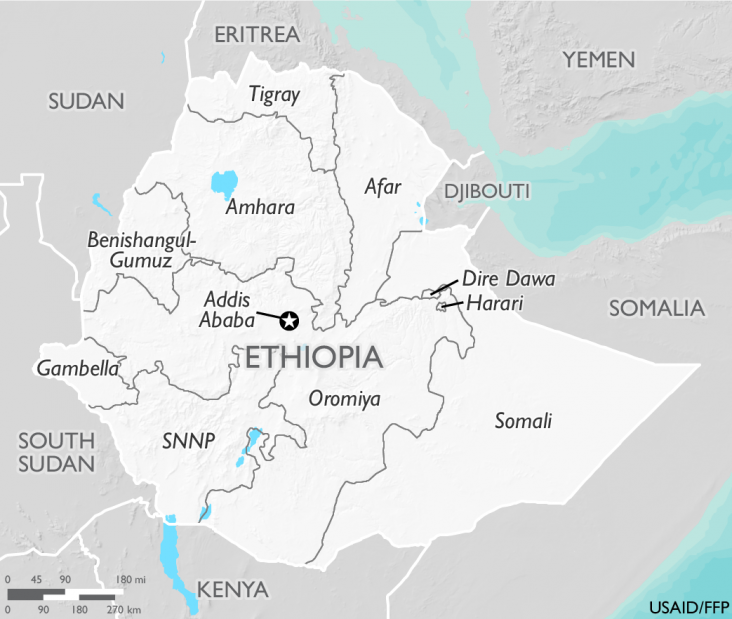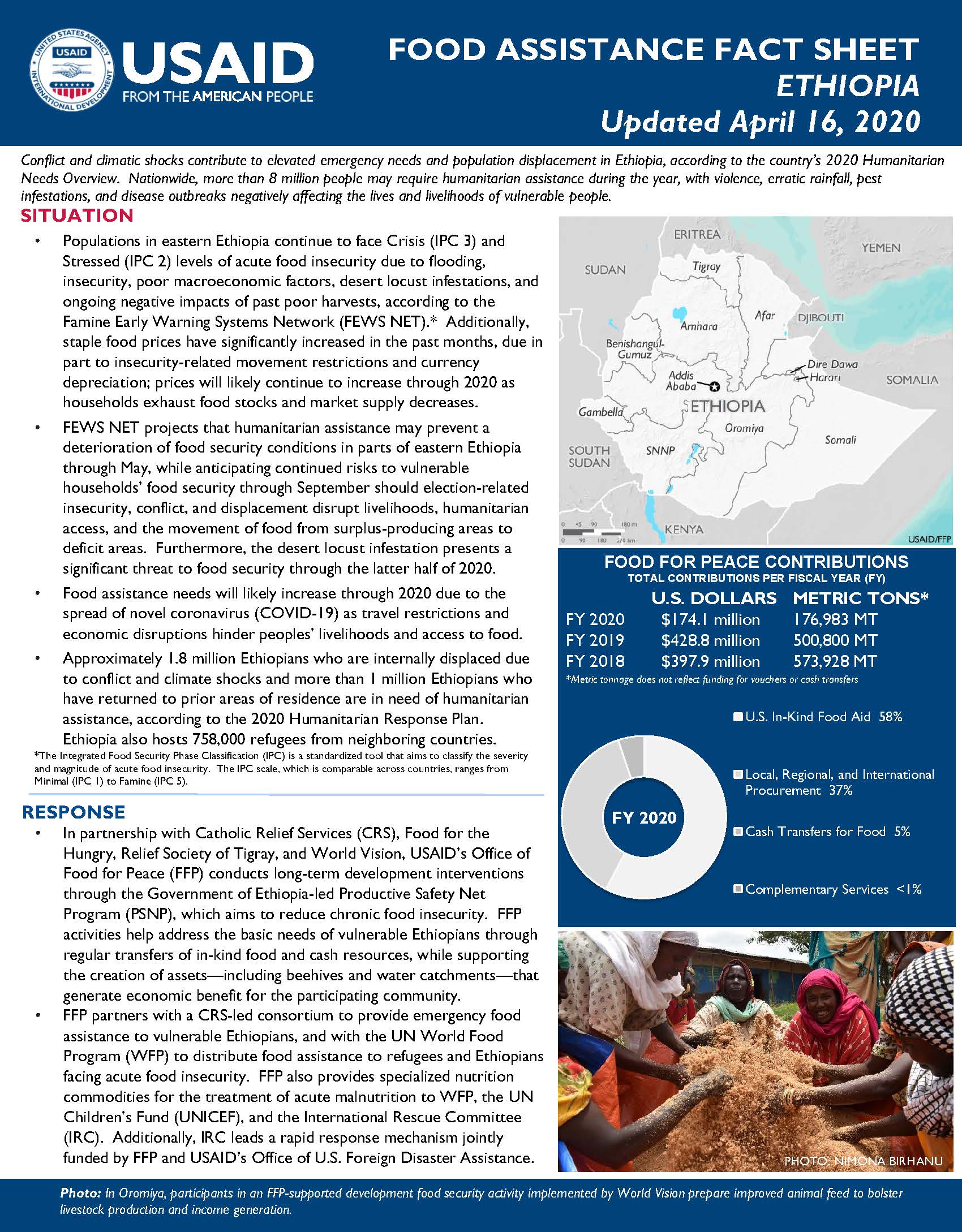- What We Do
- Agriculture and Food Security
- Democracy, Human Rights and Governance
- Economic Growth and Trade
- Education
- Environment and Global Climate Change
- Gender Equality and Women's Empowerment
- Global Health
- Humanitarian Assistance
- Transformation at USAID
- Water and Sanitation
- Working in Crises and Conflict
- U.S. Global Development Lab
Speeches Shim

April 16, 2020
Conflict and climatic shocks contribute to elevated emergency needs and population displacement in Ethiopia, according to the country’s 2020 Humanitarian Needs Overview. Nationwide, more than 8 million people may require humanitarian assistance during the year, with violence, erratic rainfall, pest infestations, and disease outbreaks negatively affecting the lives and livelihoods of vulnerable people.
Situation
- Populations in eastern Ethiopia continue to face Crisis (IPC 3) and Stressed (IPC 2) levels of acute food insecurity due to flooding, insecurity, poor macroeconomic factors, desert locust infestations, and ongoing negative impacts of past poor harvests, according to the Famine Early Warning Systems Network (FEWS NET).* Additionally, staple food prices have significantly increased in the past months, due in part to insecurity-related movement restrictions and currency depreciation; prices will likely continue to increase through 2020 as households exhaust food stocks and market supply decreases.
- FEWS NET projects that humanitarian assistance may prevent a deterioration of food security conditions in parts of eastern Ethiopia through May, while anticipating continued risks to vulnerable households’ food security through September should election-related insecurity, conflict, and displacement disrupt livelihoods, humanitarian access, and the movement of food from surplus-producing areas to deficit areas. Furthermore, the desert locust infestation presents a significant threat to food security through the latter half of 2020.
- Food assistance needs will likely increase through 2020 due to the spread of novel coronavirus (COVID-19) as travel restrictions and economic disruptions hinder peoples’ livelihoods and access to food.
- Approximately 1.8 million Ethiopians who are internally displaced due to conflict and climate shocks and more than 1 million Ethiopians who have returned to prior areas of residence are in need of humanitarian assistance, according to the 2020 Humanitarian Response Plan. Ethiopia also hosts 758,000 refugees from neighboring countries.
Food Assistance Fact Sheet - Ethiopia ![]() (pdf - 269k)
(pdf - 269k)
* The Integrated Food Security Phase Classification (IPC) is a standardized tool that aims to classify the severity and magnitude of food insecurity. The IPC scale, which is comparable across countries, ranges from Minimal—IPC 1—to Famine—IPC 5.
Response
- In partnership with Catholic Relief Services (CRS), Food for the Hungry, Relief Society of Tigray, and World Vision, USAID’s Office of Food for Peace (FFP) conducts long-term development interventions through the Government of Ethiopia-led Productive Safety Net Program (PSNP), which aims to reduce chronic food insecurity. FFP activities help address the basic needs of vulnerable Ethiopians through regular transfers of in-kind food and cash resources, while supporting the creation of assets—including beehives and water catchments—that generate economic benefit for the participating community.
- FFP partners with a CRS-led consortium to provide emergency food assistance to vulnerable Ethiopians, and with the UN World Food Program (WFP) to distribute food assistance to refugees and Ethiopians facing acute food insecurity. FFP also provides specialized nutrition commodities for the treatment of acute malnutrition to WFP, the UN Children’s Fund (UNICEF), and the International Rescue Committee (IRC). Additionally, IRC leads a rapid response mechanism jointly funded by FFP and USAID’s Office of U.S. Foreign Disaster Assistance.
Food for Peace Contributions:
| U.S. Dollars | Metric Tons | |
|---|---|---|
| Fiscal Year 2020 | $174.1 million | 176,983 MT |
| Fiscal Year 2019 | $428.8 million | 500,800 MT |
| Fiscal Year 2018 | $397.9 million | 573,928 MT |
* Metric tonnage does not reflect funding for vouchers or cash transfers.
Country-Specific Information
- Ethiopia Bellmon Analysis FY 2019-2020
- Crop Availability and Market Analysis in Ethiopia for 2016/2017 and Estimations for 2017/2018
- Ethiopia FY 2016 Country Specific Information
- Ethiopia Country Development Cooperation Strategy 2011-2015
- Climate Variability and Change in Ethiopia - Summary Findings
- Food Security Country Framework - Ethiopia
- Multi-Year Annual Program Statement for a Rapid Response Nutrition and WASH Program in Ethiopia
- Public Consultation Notes on Notice of Intent to Issue Multi-Year Annual Program Statement for a Rapid Response Nutrition and WASH Program
- Productive Safety Net Program Phase IV Program Implementation Manual
- Productive Safety Net Program Phase IV - Capacity Development Strategy
- Examples of Collaboration Indicators for Ethiopia DFAP Applicants – RISE Workshop
Related Resources
- Feed the Future Initiatives in Ethiopia
- Fiscal Year 2019 Ethiopia DFSA Fact Sheet - Catholic Relief Services
- Fiscal Year 2019 Ethiopia DFSA Fact Sheet - Food for the Hungry
- Fiscal Year 2019 Ethiopia DFSA Fact Sheet - Relief Society of Tigray
- Fiscal Year 2019 Ethiopia DFSA Fact Sheet - World Vision
- South Sudanese Fleeing Conflict Find Food, Sanctuary in Ethiopia
- As Ethiopia Restores Watersheds, Landless Youth Find Sweet Rewards
- (Re)assessing the Relationship Between Food Aid and Armed Conflict [PDF, 171 KB]


Comment
Make a general inquiry or suggest an improvement.